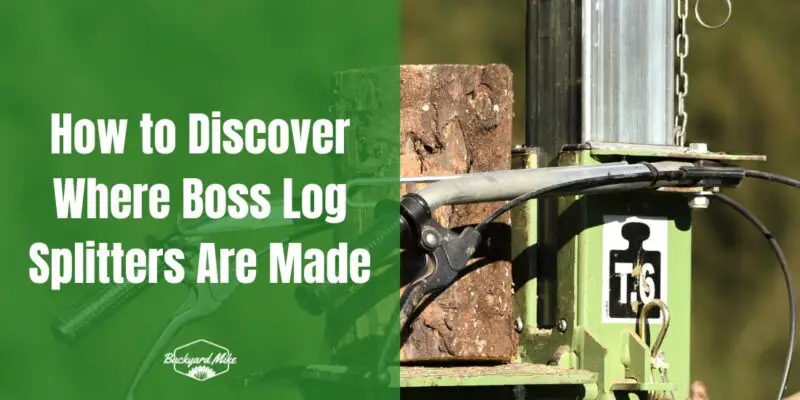To discover where Boss log splitters are made, start by exploring the company's origins and manufacturing processes. Research the specific components, such as hydraulic systems and engines, to gain insights into production locations. Consider the distribution network, noting where products are shipped and sold. Review customer feedback for clues about manufacturing reliability. These steps will guide your understanding of production environments, and further exploration might reveal more about their manufacturing processes and locations.
Key Takeaways
- Investigate Boss Industrial's manufacturing processes and patented hydraulic systems for clues on production locations.
- Research facilities known for high-quality manufacturing and innovative yard equipment to identify potential production sites.
- Analyze global distribution networks and regional market trends for insights on manufacturing origins.
- Consider customer reviews mentioning product quality and design, which may hint at manufacturing locations.
- Examine environmental regulations in key markets that could impact manufacturing site decisions.
Understanding the Company Origins
To understand the origins of Boss Industrial, it's important to recognize the company's reputation as a key player in the heavy-duty yard equipment market. While specific founding details aren't widely documented, Boss Industrial has cemented itself as a significant force in the industry. With a history rooted in innovation, the company has introduced features like dual-action log splitters, expanding its product lines to include chipper shredders and other yard equipment. This growth has solidified their brand reputation. Known for high-quality equipment with durable components, Boss Industrial products are trusted worldwide. Their presence in international markets through various retailers highlights their commitment to customer satisfaction, reflected in their robust warranty and after-sales service offerings. The Log Boss Splitter, manufactured in Marble Rock, Iowa since the late 1970s, exemplifies the company's focus on creating the best products for the money.
Exploring the Manufacturing Process
Boss Industrial's reputation for quality yard equipment starts on the manufacturing floor, where careful processes guarantee every log splitter meets high standards. You'll find that these manufacturing techniques are essential, as they incorporate high-quality materials and design engineering focused on versatility and ease of use. Key components like Briggs & Stratton engines and custom hydraulic systems are assembled with precision, guaranteeing consistent performance. Powered by Briggs & Stratton CR950 engine, the log splitters deliver a maximum splitting force of 27 tons. Quality assurance steps are baked into the process, with regular checks throughout production to maintain reliability. Equipment undergoes rigorous testing protocols for safety and operational efficiency. The assembly involves specialized wedges and durable frames, providing robustness and efficiency. Through these meticulous techniques, Boss Industrial guarantees each log splitter is both reliable and built to last.
Investigating the Production Locations
To uncover where Boss log splitters are made, start by looking into the company's manufacturing facilities and their global distribution network. The Boss Industrial EC5T20 electric wood splitter is a residential-use machine known for its 5 tons of splitting force. You can check if any information is available through company press releases, reports, or by contacting their customer support, which operates 24/7. Additionally, consider visiting retail partners like Lowe's or their online platforms, as they might provide insights into sourcing and production origins.
Manufacturing Facility Insights
While specific details about where Boss Industrial log splitters are manufactured aren't readily available, you can start your investigation by exploring potential production locations. Look into manufacturing techniques and production efficiency to assess where these log splitters might be produced. Consider the use of patented hydraulic systems and robust engines like the Briggs & Stratton CR950. These components' origins can provide clues about the production process. Research facilities known for high-quality manufacturing, focusing on those with a reputation for innovation and efficiency improvements. Understanding the manufacturing environment, such as quality control measures and material selection, can also guide you. Fast gating in Raman spectroscopy is crucial for rejecting fluorescence contributions from samples, which can obscure weak signals, and this principle of minimizing interference can be applied to enhance production processes in manufacturing.
Global Distribution Network
Understanding the global distribution network of Boss Industrial log splitters can provide valuable insights into their potential production locations.
With a strong presence in the global market, particularly in North America, Europe, and Asia Pacific, Boss Industrial must strategically navigate various distribution channels. They utilize online sales platforms and retail stores to reach diverse consumer bases, meeting the specific demands of each region. Freight delivery and direct purchases are common, ensuring that even remote areas have access to their products. As you explore the production roots of Boss log splitters, consider how regional market trends, like technological advances and environmental regulations, might influence manufacturing locations. The adjustable design of Boss Industrial log splitters for any category 1 or category 2 3-point hitch size exemplifies their commitment to versatility and adaptability in different markets.
Analyzing Product Specifications for Clues
When you're looking to discover where Boss log splitters are made, examining the product specifications can offer valuable clues. Focus on product features and assembly details, as these can hint at the origin. For instance, the use of high-quality engines like Briggs & Stratton suggests a connection to well-known manufacturing regions. The robust design, including strong hydraulics and ergonomic considerations, may indicate skilled craftsmanship. Assembly requirements also provide insights; many splitters require assembly, possibly hinting at international shipping. The presence of California Proposition 65 warnings suggests adherence to specific U.S. regulations. Boss Industrial, located in Naperville, IL, has been known for high-quality workmanship and strong hydraulics since 2011.
Examining Distribution and Retail Networks
To uncover where Boss log splitters originate, it's helpful to contemplate how they're distributed and sold. Start by examining the supply chain, which involves delivering components and finished products from manufacturing sites to retailers like Lowe's. Boss Industrial offers a range of log splitters with various capacities, including both gas and electric models. These retail partnerships are essential as they guarantee that log splitters are available both online and in physical stores. Boss log splitters are sold on e-commerce platforms, broadening their reach and accessibility. Understanding how these products are positioned in retail networks can offer insights into their origins. The effective distribution strategy guarantees broad market coverage and cost efficiency, while maintaining supply chain resilience is key to keeping products available.
Gathering Insights From Customer Reviews
[Why explore customer reviews when trying to uncover more about Boss log splitters? Customer feedback offers valuable insights into product performance, helping you determine if these splitters meet your needs.
Reviews reveal that the Boss Industrial ES7T20 is praised for its efficiency and ease of use, which are essential for small to medium tasks. Users appreciate its compact design, while some note setup challenges, like accessing the hydraulic fluid dipstick.
Feedback highlights the splitter's reliability, with many customers expressing satisfaction with its durability and performance compared to other brands. The electric motor with a 2 HP rating is a significant factor contributing to its strong performance and appeal among users.
Suggestions for improvements, such as larger wheels, reflect user desires for enhanced mobility. By examining these reviews, you can gauge how well Boss log splitters align with your specific requirements and expectations.
Frequently Asked Questions
Are Boss Log Splitters Eco-Friendly?
You'll find Boss log splitters eco-friendly due to their sustainable materials and energy efficiency. They're designed to minimize emissions, reduce waste, and operate quietly, making you feel good about using them in any environment.
Can I Tour the Manufacturing Facility?
While whispers of possibility linger, public tours of Boss Industrial's manufacturing processes and facility locations aren't widely available. You might consider reaching out directly to explore potential opportunities to connect with the heart of their craftsmanship.
Do They Offer Custom Log Splitter Designs?
You won't find custom designs at Boss Industrial, but other manufacturers like WoodBoss cater to customer requests. If you're seeking that personal touch, explore options where customization brings you closer to your ideal log splitter.
Is There a Warranty for International Buyers?
You'll feel like a global citizen with Boss Industrial's warranty for international buyers! They offer shipping policies and international support, ensuring you're never alone when tackling those colossal warranty claims. You're part of the Boss family!
How Often Are New Models Released?
You might think about model features when considering the release schedule for new Boss Log Splitters. They don't release new models frequently, but when they do, it's to improve performance and meet your needs.
Conclusion
To uncover where Boss log splitters are made, start by understanding the company's origins and manufacturing process. Investigate production locations by examining product specifications for hidden clues. Analyze distribution and retail networks for additional insights. Finally, gather information from customer reviews to piece together the puzzle. Like a detective following breadcrumbs, each step brings you closer to the truth. Stay focused, and you'll reveal the manufacturing secrets that lie beneath the surface.


